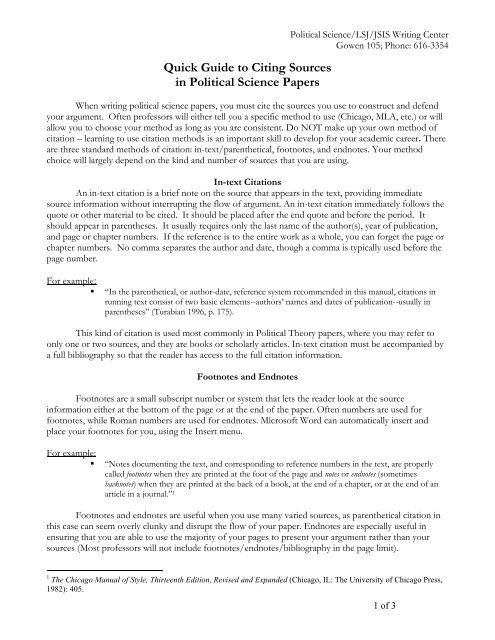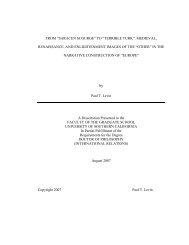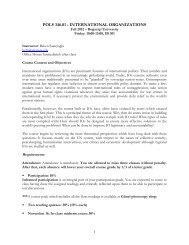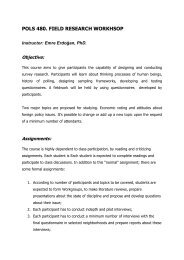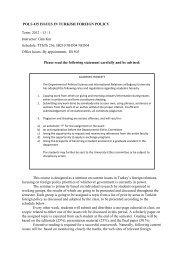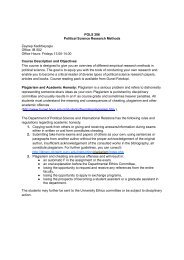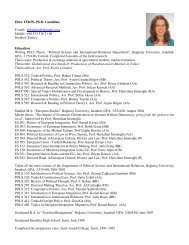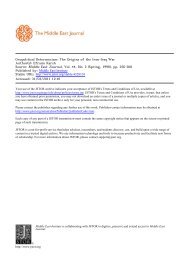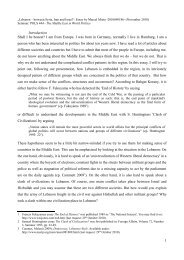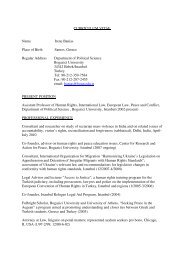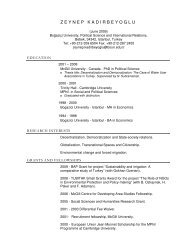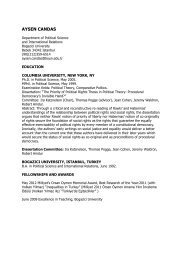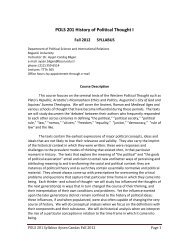Quick Guide to Citing Sources in Political Science Papers
Quick Guide to Citing Sources in Political Science Papers
Quick Guide to Citing Sources in Political Science Papers
Create successful ePaper yourself
Turn your PDF publications into a flip-book with our unique Google optimized e-Paper software.
<strong>Quick</strong> <strong>Guide</strong> <strong>to</strong> <strong>Cit<strong>in</strong>g</strong> <strong>Sources</strong><br />
<strong>in</strong> <strong>Political</strong> <strong>Science</strong> <strong>Papers</strong><br />
<strong>Political</strong> <strong>Science</strong>/LSJ/JSIS Writ<strong>in</strong>g Center<br />
Gowen 105; Phone: 616-3354<br />
When writ<strong>in</strong>g political science papers, you must cite the sources you use <strong>to</strong> construct and defend<br />
your argument. Often professors will either tell you a specific method <strong>to</strong> use (Chicago, MLA, etc.) or will<br />
allow you <strong>to</strong> choose your method as long as you are consistent. Do NOT make up your own method of<br />
citation – learn<strong>in</strong>g <strong>to</strong> use citation methods is an important skill <strong>to</strong> develop for your academic career. There<br />
are three standard methods of citation: <strong>in</strong>-text/parenthetical, footnotes, and endnotes. Your method<br />
choice will largely depend on the k<strong>in</strong>d and number of sources that you are us<strong>in</strong>g.<br />
In-text Citations<br />
An <strong>in</strong>-text citation is a brief note on the source that appears <strong>in</strong> the text, provid<strong>in</strong>g immediate<br />
source <strong>in</strong>formation without <strong>in</strong>terrupt<strong>in</strong>g the flow of argument. An <strong>in</strong>-text citation immediately follows the<br />
quote or other material <strong>to</strong> be cited. It should be placed after the end quote and before the period. It<br />
should appear <strong>in</strong> parentheses. It usually requires only the last name of the author(s), year of publication,<br />
and page or chapter numbers. If the reference is <strong>to</strong> the entire work as a whole, you can forget the page or<br />
chapter numbers. No comma separates the author and date, though a comma is typically used before the<br />
page number.<br />
For example:<br />
• “In the parenthetical, or author-date, reference system recommended <strong>in</strong> this manual, citations <strong>in</strong><br />
runn<strong>in</strong>g text consist of two basic elements--authors’ names and dates of publication--usually <strong>in</strong><br />
parentheses” (Turabian 1996, p. 175).<br />
This k<strong>in</strong>d of citation is used most commonly <strong>in</strong> <strong>Political</strong> Theory papers, where you may refer <strong>to</strong><br />
only one or two sources, and they are books or scholarly articles. In-text citation must be accompanied by<br />
a full bibliography so that the reader has access <strong>to</strong> the full citation <strong>in</strong>formation.<br />
Footnotes and Endnotes<br />
Footnotes are a small subscript number or system that lets the reader look at the source<br />
<strong>in</strong>formation either at the bot<strong>to</strong>m of the page or at the end of the paper. Often numbers are used for<br />
footnotes, while Roman numbers are used for endnotes. Microsoft Word can au<strong>to</strong>matically <strong>in</strong>sert and<br />
place your footnotes for you, us<strong>in</strong>g the Insert menu.<br />
For example:<br />
• “Notes document<strong>in</strong>g the text, and correspond<strong>in</strong>g <strong>to</strong> reference numbers <strong>in</strong> the text, are properly<br />
called footnotes when they are pr<strong>in</strong>ted at the foot of the page and notes or endnotes (sometimes<br />
backnotes) when they are pr<strong>in</strong>ted at the back of a book, at the end of a chapter, or at the end of an<br />
article <strong>in</strong> a journal.” 1<br />
Footnotes and endnotes are useful when you use many varied sources, as parenthetical citation <strong>in</strong><br />
this case can seem overly clunky and disrupt the flow of your paper. Endnotes are especially useful <strong>in</strong><br />
ensur<strong>in</strong>g that you are able <strong>to</strong> use the majority of your pages <strong>to</strong> present your argument rather than your<br />
sources (Most professors will not <strong>in</strong>clude footnotes/endnotes/bibliography <strong>in</strong> the page limit).<br />
1 The Chicago Manual of Style, Thirteenth Edition, Revised and Expanded (Chicago, IL: The University of Chicago Press,<br />
1982): 405.<br />
1 of 3
Bibliography/<strong>Sources</strong> Consulted<br />
<strong>Political</strong> <strong>Science</strong>/LSJ/JSIS Writ<strong>in</strong>g Center<br />
Gowen 105; Phone: 616-3354<br />
In-text citation, footnotes and endnotes direct attention <strong>to</strong> the more detailed references, which<br />
provide complete source <strong>in</strong>formation <strong>to</strong> aid further research. (In some cases, if you use footnotes or<br />
endnotes, an additional bibliography is not required).<br />
The examples that follow show proper forms for common k<strong>in</strong>ds of references. List all references<br />
alphabetically by author. Give the full first name, <strong>in</strong>stead of an <strong>in</strong>itial, unless the author is widely known by<br />
the first <strong>in</strong>itials. Double-space between entries and <strong>in</strong>dent all l<strong>in</strong>es after the first <strong>in</strong> each entry. When there<br />
are several works by the same author, place them <strong>in</strong> chronological order, with the earliest publication first,<br />
repeat<strong>in</strong>g the name of the author with each new entry.<br />
Book - One Author 2<br />
• Kessel, John H. 1968. The Goldwater Coalition: Republican Strategies <strong>in</strong> 1964. Indianapolis: Bobbs-<br />
Merrill.<br />
The author's name and date - the bits of <strong>in</strong>formation <strong>in</strong> the citation - appear first, followed by the book title,<br />
place of publication, and the publisher. If the city is well-known, there is no need <strong>to</strong> identify the state (or DC). Use<br />
postal acronyms for states (MA, OH). Chapter and page numbers should be <strong>in</strong> the citations, not the references.<br />
Book - Two Authors<br />
• Sorauf, Frank J., and Paul Allen Beck. 1988. Party Politics <strong>in</strong> America. 6th ed. Glenview, IL: Scott<br />
Foresman.<br />
Chapter <strong>in</strong> Multiauthor Collection<br />
• Hermann, Margaret G. 1984. "The Party Organization and Its Activities." In Approaches <strong>to</strong> the Study<br />
of Party Organization, ed. William J. Crotty. Bos<strong>to</strong>n: Allyn & Bacon.<br />
Do not use a form analogous <strong>to</strong> this one for a chapter <strong>in</strong> a s<strong>in</strong>gle author book. Rather, <strong>in</strong>dicate the whole book<br />
and specify the chapter <strong>in</strong> the citation.<br />
Edited Collections<br />
• Ball, Terence, James Farr, and Russell L. Hanson, eds. 1988. <strong>Political</strong> Innovation and Conceptual Change.<br />
New York: Cambridge University Press.<br />
Note that the first author's name is listed with the last name first while the rema<strong>in</strong><strong>in</strong>g authors are listed first<br />
name then last name.<br />
Government Documents 3<br />
• U.S. Congress. Senate. Committee on Foreign Relations. 1956. The Mutual Security Act. 84th Cong.,<br />
2d sess., S. Rept. 2273.<br />
Congressional Reports and Documents - The reference beg<strong>in</strong>s with U.S. Congress, followed by any committee,<br />
year, title, Congress, sessions, and report or document number of committee pr<strong>in</strong>t number. Include bills and<br />
resolutions and publications by commissions <strong>in</strong> this category.<br />
2 Each of these references is shown us<strong>in</strong>g MLA format. For Chicago style, move the date <strong>to</strong> the end of the citation (see<br />
specific style guides for more <strong>in</strong>formation).<br />
3 For more detail, see Kate L. Turabian's Manual for Writers of Term <strong>Papers</strong>, Theses and Dissertations, chapter 12.<br />
2 of 3
<strong>Political</strong> <strong>Science</strong>/LSJ/JSIS Writ<strong>in</strong>g Center<br />
Gowen 105; Phone: 616-3354<br />
Journal Articles<br />
• Aldrich, John H. 1980. "A Dynamic Model of Presidential Nom<strong>in</strong>ation Campaigns." American<br />
<strong>Political</strong> <strong>Science</strong> Review 74:651-69.<br />
The article title takes headl<strong>in</strong>e capitalization regardless of how it was handled <strong>in</strong> the actual journal. Allow no<br />
space between the colon and the page numbers.<br />
Magaz<strong>in</strong>e Articles<br />
• Prufer, Olaf. 1964. "The Hopewell Cult." Scientific American, December.<br />
References <strong>to</strong> popular magaz<strong>in</strong>es require only the author, year, article title, magaz<strong>in</strong>e title, month, and day<br />
(for a weekly or bimonthly).<br />
Note that all citations from electronic sources require that you record when you accessed the<br />
sources (as <strong>in</strong>dicated by the date <strong>in</strong> parentheses at the end of the citation).<br />
Citations from a World Wide Web Site<br />
• University of Chicago Press, University of Chicago Press Onl<strong>in</strong>e, http://www.press.uchicago.edu/<br />
(accessed January 21, 2001).<br />
Article from a News Service<br />
• Associated Press. 28 Oct. 1998 “Trade Order Could Help U.S. Apples Sell <strong>in</strong> Japan.” The Seattle<br />
Times Onl<strong>in</strong>e. http://archives.seattletimes.com/cgib<strong>in</strong>/texis/web/vortex/display?slug=trad&date=19981028&query=apples<br />
(4 Apr. 2000).<br />
Electronic Copy of a Journal Article Retrieved from Database<br />
• Lee, M., and R. Larsen. 2002. “The Korean ‘Exam<strong>in</strong>ation Hell”: Long Hours of Study<strong>in</strong>g, Distress,<br />
and Depression.” Journal of Youth and Adolescence 29 (8 Nov. 2001).<br />
3 of 3


